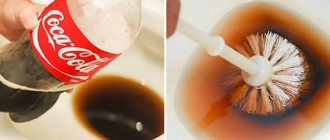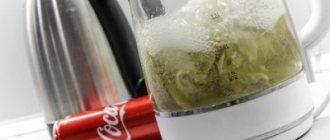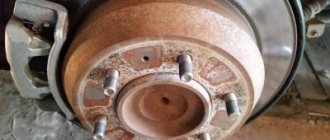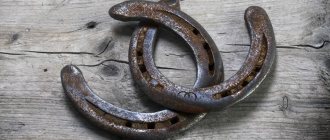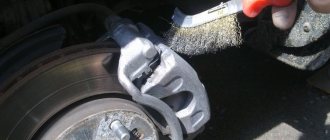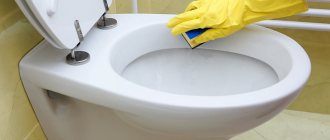Hello, dear readers of my life blog!
As he said in the announcement: “ Live forever, learn forever!”
" So I learned this folk wisdom myself.
I recently encountered the following problem: the locking nuts on the wheels of my car (KIA RIO X-Line) began to rust. And it seems like a trifle, but the car is new, and so are the wheels. And besides, the wheels are black and polished. Therefore, rusty nuts spoiled the whole look. So I asked myself: “How to clean rusty nuts from rust without much effort?”
And it turned out that my problem, if it is not running, has a completely acceptable and budget-friendly solution - the most ordinary Coca-Cola.
Therefore, in this article I will share my life hack on how I used regular Coca-Cola to remove rust from the chrome nuts on the wheels of my car.
How to use Coca-Cola so that it eats away rust?
Surely many housewives have heard that you can remove rust with cola.
Corrosion easily spoils the appearance of things, while at the same time reducing their service life. Therefore, people regularly invent new ways to combat it. For severe contamination, it is still better to use specially developed preparations. But sometimes ordinary cleaning products that can be found on the shelves of any store are enough for cleaning. Cola is a universal product that removes stains from chrome surfaces, plumbing fixtures and even fabrics.
Rules for storing silver jewelry
It is much better to store jewelry in a special box with separate compartments for rings, chains, bracelets and earrings, because scratches and defects quickly appear on items thrown together. Instead of a box, you can use small plastic bags for each item.
It is better to choose a cool, dry place with normal humidity for storage. Silver objects do not react well to changes in humidity and temperature, so it is advisable to store them away from heating appliances.
Caring for silver jewelry
To preserve the beauty of white metal jewelry, adhere to the following care rules:
it is important not to allow objects to become covered with dust; the surface is periodically wiped with a soft cloth; before visiting the gym, swimming pool, sauna and before applying cosmetics, remove silver jewelry; When doing homework, it is better to remove the rings so that there are no scratches on them; things made of white metal are periodically cleaned of darkening, using any of the methods described above.
Any silver jewelry can be preserved in its original form and its beauty can be maintained during wear if you follow simple rules of storage and care, and also periodically use various cleaning methods to remove the black deposits that form.
Bathroom
When cleaning the toilet, you need to pour 1-2 liters of cola into the bowl so that the liquid covers all the limescale. Leave overnight. Then use a toilet brush to wash the most problematic areas, and then flush the water. Cola is convenient because it helps remove not only stains, but also persistent unpleasant odors.
When treating a bathtub or sink, just wipe it with a cloth soaked generously in soda, leave it for a while and rinse with water.
A drink with an expiration date will not work. Only fresh cola eats away rust quickly and efficiently.
Products for removing corrosion from metal
Corrosive processes affecting metal worsen its characteristics, and if no measures are taken, they contribute to destruction. You can cope with the problem at home using various acids.
Lemon
Using citric acid to eliminate corrosion can help with minor metal damage.
Application:
- Dissolve citric acid in water in a 1:1 ratio.
- Apply to the corroded area. You can soak a rag in the liquid and apply it to the damaged metal.
- Leave for several hours, making sure that the metal surface remains moisturized.
- Remove loose rust with a brush or scraper.
- Rinse the area of metal exposed to the acid with water.
The best result in removing rust can be achieved by mixing it in equal proportions with vinegar. More information about the use of citric acid against rust can be found here.
Sulfuric
Sulfuric acid will help solve the corrosion problem quickly and effectively. An aqueous solution is prepared for use. Its density should be no more than 1.15 g/cm³, since a higher concentration can damage the metal.
Experts advise combining acid with an inhibitor. The solution should contain sulfuric acid (5%), 1 liter of water and methenamine (500 mg).
The procedure for exposure involves dipping the metal into the solution for half an hour. If the object is large, then surface treatment with a brush is used. At the end of the exposure, it is recommended to treat the metal with a weak solution of ammonia to neutralize it.
Orthophosphoric
Phosphoric acid is one of the commonly used components of ready-made rust removers and converters. It can be used in the form of a solution.
Work order:
- clean the metal surface by mechanically removing the top layer of rust;
- prepare an acid solution with a concentration of 15-20%;
- treat the surface.
As a result of application, a film is formed on the metal surface, which can protect the surface from further corrosion. And it can serve as a primer before painting. More information about the use of phosphoric acid in the fight against rust can be found here.
Sorrel
The use of oxalic acid requires the use of a respirator and glasses.
Algorithm of actions:
- The area of metal that requires rust removal must be washed with soapy water or dishwashing detergent.
- Rinse with water.
- Wipe dry.
- Pour 0.3 liters of water into a separate container.
- Add 6 tsp to water. acids.
- Place the item in the container.
- Leave for half an hour.
- Clean off plaque.
- Rinse the item with hot water.
- Wipe with a napkin.
If the item cannot be cleaned by immersion in a container, the damaged area should be moistened with the prepared solution and left for 30-40 minutes. After this, clean off the deposits and wash the metal.
Vinegar
Table vinegar can be used to remove rust due to the acetic acid it contains.
The procedure for carrying out work using the immersion method:
- prepare a container into which the rusty metal object can be immersed entirely;
- fill the container with vinegar;
- place a metal product in the solution;
- stand for several hours (at least 2);
- get an item;
- using a wire brush, remove rust;
- wash the item.
If the items are very small, it is possible, after soaking the items in vinegar, to use aluminum foil to remove plaque.
The proposed method is convenient for processing small metal objects:
- coins;
- bolts;
- nuts;
- keys, etc.
If you need to process a large metal product (for example, a shovel, fittings, etc.), you will have to use this method:
- Soak a rag generously in vinegar.
- Cover the area affected by corrosion with a rag soaked in vinegar.
- Leave for several hours (at least 2), periodically moistening the rag with vinegar.
- Clean off rust.
- Wash off any remaining vinegar from the metal surface.
Useful information about the method of removing rust using vinegar can be found in this article.
Automobile
With the same success, Pepsi will come to the aid of motorists. If the glass cleaner doesn't do the job, you can take the glass cleaner and gently apply it to the stains. After some time, the plaque will begin to dissolve. Then remove any remaining soda from the glass with a dry cloth.
In exactly the same way, cola is used to remove corrosion on the bumper and battery. Just use a hard sponge instead of a napkin.
Defrosting glass
If your car window is covered with ice, you don’t have to immediately run for hot water or spend a long and painful time trying to remove the ice from the surface. You can fill the window with soda and wait a little.
Surprisingly, the ice layer actually begins to melt and then all that remains is to carefully remove it from the glass.
Small items
Cleaning small items, such as cutlery or coins, takes place in a pre-prepared plastic container. All products are carefully placed in it and filled with liquid so that they are completely hidden. Within a few days the devices will become much cleaner. All that remains is to thoroughly wipe the surface with a sponge or towel.
While the products are being processed, they should not be touched. Let them lie quietly while the soda dissolves plaque and rust. If the stains were not removed in one go, the procedure can always be repeated.
An old, rusty bolt that is difficult to unscrew should be wrapped in a napkin soaked in Coca-Cola for several hours. Then wipe with a clean sponge and try to unscrew again.
It is worth considering that the stake does not remove rust from all surfaces equally easily. Red stains from chrome or sanitary ware can be cleaned off with a bang, but oxides directly from iron are reluctant to leave - it takes much more time.
Folk remedies for cleaning rust from tools
You can remove rust from metal keys with simple homemade solutions. The following substances are suitable for removing signs of corrosion:
- Table vinegar. Water and acid are mixed in a container in a 1:1 ratio. The instrument is immersed in the liquid for several hours, then the objects are taken out and thoroughly wiped with a dry cloth or rag. Remains of rust are removed with a hard sponge.
- Lemon juice. An effective product that helps dissolve rust that has formed on bolts or other small metal products. The liquid is diluted in equal proportions with water. Instruments are soaked in the mixture for 3-4 hours. If there is no juice, it can be replaced with citric acid.
- Soda. A small amount of water is added to the powder. The resulting slurry is applied to the surface affected by rust and rubbed in with a metal brush. Then the instruments are washed with running water and dried.
- Coca Cola. Helps easily get rid of rust that appears on tools. Objects damaged by corrosion are placed in the liquid and left for several hours, then washed well.
Why is cola used for cleaning?
Some people, seeing how the drink removes rust, refuse to buy it. They say it’s all chemicals, from which you can easily get a stomach ulcer. Fears, of course, are greatly exaggerated. If you drink Pepsi or Coke in limited quantities, and not 1-2 liters every day, there will be no more harm from such a drink than from any other soda.
But then a logical question arises: what about its cleaning properties? The answer is simple: cola is the most advertised drink among sodas. Any lemonade has similar qualities, because it contains citric acid. Many housewives know how this product easily cleans grease and other stains.
The effect of using cola may be slightly greater than others due to the phosphoric acid content. It minimizes the risk of re-occurrence of corrosion on metal surfaces by forming a protective film on them. But there is not much difference between them.
Laser cleaning of metal from corrosion
In addition to the methods described above, there is another method of combating metal corrosion. It involves the use of laser equipment. This is a modern technology that is characterized by high speed, quality and efficiency. It has only one drawback - its high cost, so not everyone can afford to use it. Due to the high cost of the method, it is used to clean precious metals from corrosion and plaque.
The advantages of this method include the following factors:
- no release of harmful substances;
- automatic shutdown of the laser beam;
- ability to work with combined materials;
- high speed and quality;
- no need to replace consumables.
The cleaning procedure involves applying laser radiation to areas that need to be cleaned from corrosion. The laser beam acts exclusively on contaminated surfaces. The beam is reflected from clean areas, and damaged areas are heated, thereby removing plaque from them.
During laser exposure, heating causes a transformation of the structure, which ultimately causes plaque exfoliation. As the power of the equipment increases, the process of plaque evaporation occurs. The equipment is capable of heating workpieces to a temperature of 16.5 thousand degrees Celsius. The cleaning process is performed automatically. Initially, the working surface is scanned, and then the focused beam processes the part.
This is interesting! The use of such equipment for home use is irrational due to its high cost.
In what cases is there no result?
After seeing how cola and rust interact with each other, housewives may be inspired to try using it to remove other stains. But it was not there. In some cases, this drink is of no use.
The cola can be safely put aside when removing:
- fat and oil - your usual detergent will help here;
- paint or ink - alcohol and specially developed preparations can better cope with this problem.
Also, cola will be useless against bacteria and germs. You can get rid of them only with the help of disinfectants.
Inflating the wheel
This is a fairly specific method, but it can help in an unexpected situation:
- The wheel is removed from the car and placed on the ground.
- Next, you need to find a hose of a diameter that would fit the camera nipple.
- A hole is made in the bottle cap and then connected to the camera.
- Carbonated liquid fills the chamber.
- Then the tire needs to be shaken well and put back in place.
Of course, such inflation will not give good pressure, imbalance will appear, but it will help you get to the nearest tire repair shop or go to a crowded place where you can find a regular pump.
How to use Coca-Cola so that it eats away rust?
Surely many housewives have heard that you can remove rust with cola. Corrosion easily spoils the appearance of things, while at the same time reducing their service life. Therefore, people regularly invent new ways to combat it.
For severe contamination, it is still better to use specially developed preparations. But sometimes ordinary cleaning products that can be found on the shelves of any store are enough for cleaning. Cola is a universal product that removes stains from chrome surfaces, plumbing fixtures and even fabrics.
Recommendations
It is necessary to familiarize yourself with the advice of specialists:
- If cleaning does not remove all the rust the first time, the action can be repeated.
- Objects soaked in Coca-Cola should not be stirred, removed or exposed to other influences during cleaning.
- Cola does not have disinfectant properties, so if, for example, mold is detected, it is worth using special targeted products.
- You cannot use cola to clean complex devices with built-in electronic components and other elements that are prohibited from being exposed to liquids.
- In addition to rust, cola is also effective in combating limescale, for example, on plumbing fixtures.
Lemon juice
If you won't remove a rusty part, such as a screw or nut, one of the easiest ways to remove the rust is to use salt and lemons. Take salt and sprinkle it on the rusty area. Then squeeze lemon or lime juice over the salty, rusty stain. Next, leave it for several hours.
Next, use steel wool or any other textured cloth to remove the rust. You can also use lemon zest to remove rust without harming the metal.
Lactic acid
Before removing rust from the metal, take 50 grams of this substance and 100 ml of petroleum jelly (the components are mixed). Iron oxide under the influence of acid is converted into a salt - iron lactate, which is easily dissolved by petroleum jelly. After removing the defect, the surface should be wiped with a cloth (also moistened with the oil mentioned above).
Why is cola used for cleaning?
Some people, seeing how the drink removes rust, refuse to buy it. They say it’s all chemicals, from which you can easily get a stomach ulcer. Fears, of course, are greatly exaggerated. If you drink Pepsi or Coke in limited quantities, and not 1-2 liters every day, there will be no more harm from such a drink than from any other soda.
But then a logical question arises: what about its cleaning properties? The answer is simple: cola is the most advertised drink among sodas. Any lemonade has similar qualities, because it contains citric acid. Many housewives know how this product easily cleans grease and other stains.
The effect of using cola may be slightly greater than others due to the phosphoric acid content. It minimizes the risk of re-occurrence of corrosion on metal surfaces by forming a protective film on them. But there is not much difference between them.
How effective and profitable is cleaning with soda?
Unlike chemicals, the drink is not expensive. When using it at home, one liter is enough. In addition, when you use chemical detergents, you have to clean, spray, monitor the accuracy of the dosage, buy auxiliary things in the form of gloves, respirators, metal scrapers. The use of Cola, in turn, not only facilitates tasks such as removing rust, scale, and various stubborn stains, but also effectively copes with these problems. Therefore, the choice should be made only based on personal preferences. Millions of people have already become convinced that Cola is an indispensable assistant in everyday life, coping with many troubles without any special financial or physical costs.
Bathroom
When cleaning the toilet, you need to pour 1-2 liters of cola into the bowl so that the liquid covers all the limescale. Leave overnight. Then use a toilet brush to wash the most problematic areas, and then flush the water. Cola is convenient because it helps remove not only stains, but also persistent unpleasant odors.
When treating a bathtub or sink, just wipe it with a cloth soaked generously in soda, leave it for a while and rinse with water.
A drink with an expiration date will not work. Only fresh cola eats away rust quickly and efficiently.
Removing stubborn dirt
The stubborn stains will be cleaned by boiling.
In this way, you can return the jewelry to a light shade and remove black deposits in hard-to-reach places.
Algorithm of actions:
- Pour Coca-Cola into a small container (use half the volume of the container).
- Contaminated decorations are placed at the bottom. The sweet soda should completely cover them.
- Place the bowl with decorations on the stove and turn on the burner.
- Boil the decorations in Cola for about 10 minutes, then turn off the heat and leave them in the soda until it cools completely.
As soon as the Cola has cooled, the jewelry is removed, washed under running water and rubbed with a cloth until shiny. There will be no trace left of gray plaque and black dirt.
